Art Fairs
5 Standout Young Artists to Discover at Liste 2018
Here are the rising stars of Liste founder Peter Bläuer’s valedictory fair.

Here are the rising stars of Liste founder Peter Bläuer’s valedictory fair.

by
Andrew Goldstein

With Liste’s sensitive founding director Peter Bläuer retiring this week, after 23 years of shepherding emerging artists and dealers through the turbulent early stages of their careers (always ready to drop a fee or adjust a lightbulb), there was some sadness among the older guard at this year’s fair. But, being the “young art fair,” it shouldn’t last long—there are already new generations coming up fast and furious, and when the next director is announced in August, whoever it is will be confronted by an intensely challenging art-market landscape that demands fresh solutions. In the meantime, here are some of the most exciting rising stars in Bläuer’s valedictory edition of the fair.
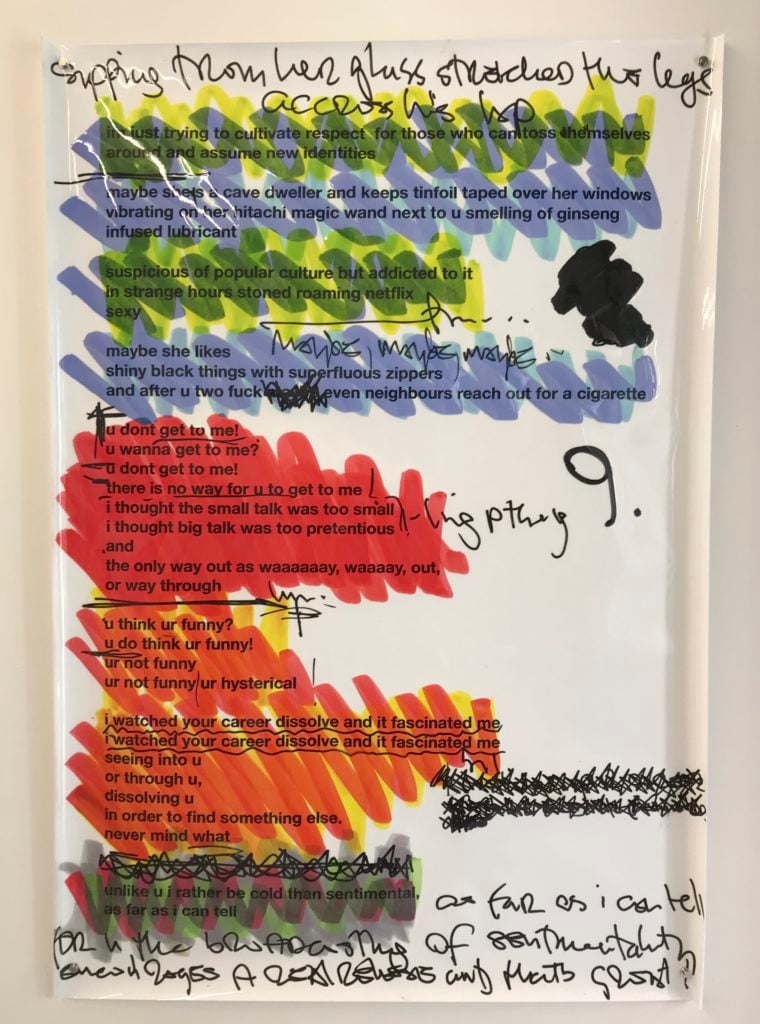
Anyone who has been driven partway crazy by the particulate forms of 21st-century communication, where words and phrases shoot out of all corners (ads, rap songs, social media posts, articles, political speeches, sociological studies, the rare book) and ricochet in the context-free ether (“dragon energy”? “ethereum-based funding vehicle”?) will be driven the rest of the way to crazytown by the performances of Nora Turato.
A 27-year-old Croatian former ad-agency graphic designer who went through Amsterdam’s top art schools—the Gerrit Rietveld Academie and Rijksakademie—Turato gathers these ambient bits of text from everywhere she can find them and stitches them into long scripts that she then Gatling-guns out in half-hour sprechgesang recitals that are as endurance-based for the audience as they are for her. The effect is a bit like listening to “The Wasteland” as composed by a bot and broadcast via Alexa.
At Liste, Turato—wearing a Balenciaga outfit, the fashion equivalent of this Eliotean “heap of broken images,” and standing atop the words “people love to pretend they’re offended”—performed a new body of work at the booth of LambdaLambdaLambda amid blown-up pages from her notebook, which a friend suggested could double as artworks due to her doodles and color-coding. (They’re now €3,800 apiece.) As fairgoers walked through the booth, the artist locked them in her eyes and addressed her stream to them, freezing them in their tracks, bewildered. Expect similar mesmerized looks in Palermo soon, where Turato will give the laid-back South Italians a taste of her antic, schizoid rendition of modern life at the opening of Manifesta.
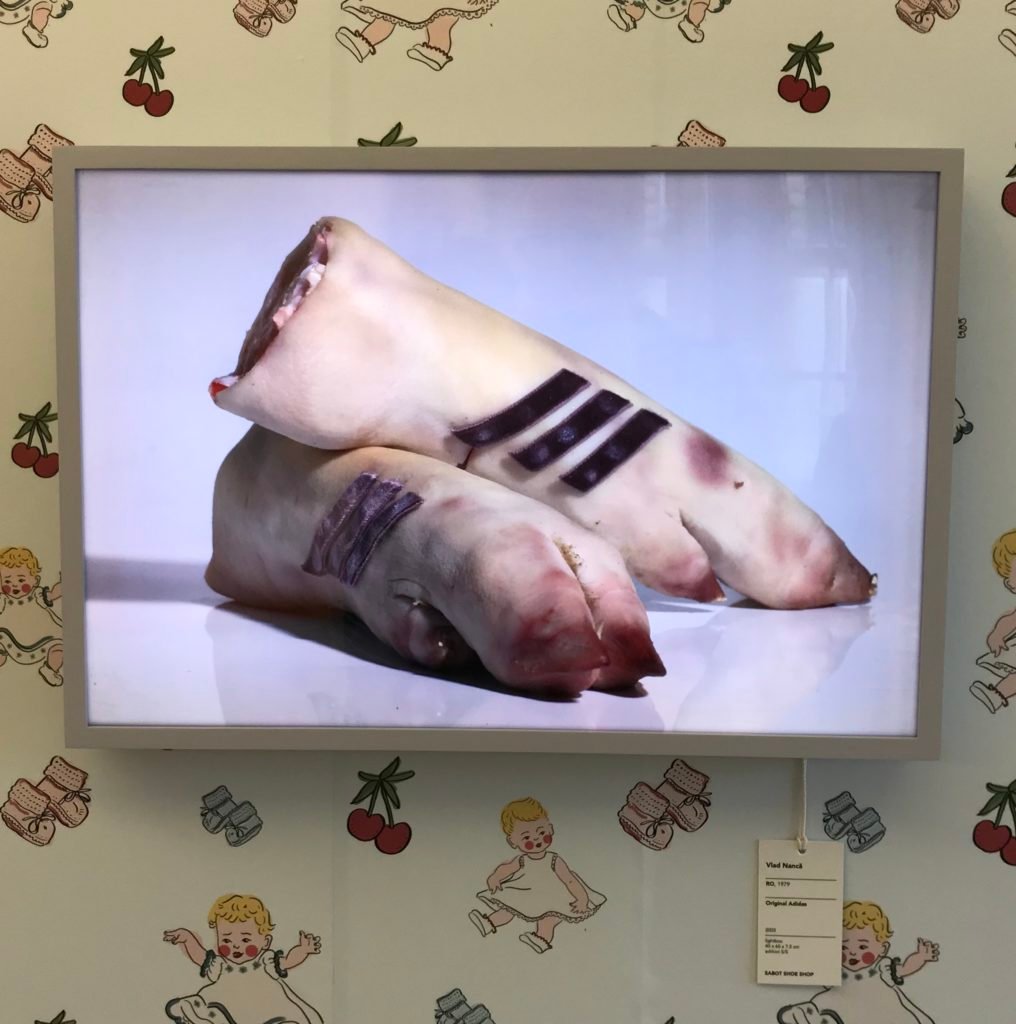
The Romanian gallery SABOT takes its name from the Dutch wooden clog that gave birth to the word “saboteur” (either because workers in the midst of a labor dispute would throw theirs into the machinery or because they’d simply clomp around in them loudly, the etymology isn’t clear), and in that spirit its nine artists have filled its booth with shoe-related works, from sculptures to paintings made through shoe-affixed brushes. For his part, the Bucharest-based artist Vlad Nancă contributed a photo of two pigs’ trotters emblazoned with the Adidas logo.
An effectively surreal image on its own, the photograph has a local backstory: during the Communist era, Romania had very slim pickings in its grocery stores, and one of the few reliable sources of meat for everyday consumption was pigs’ feet. To make these more desirable, kids in Bucharest—in the black humor that was the Soviet system’s great byproduct—called them “Adidas.” At around €5,000, this piece of culinary history would make a visually pungent addition to the capitalist kitchen.
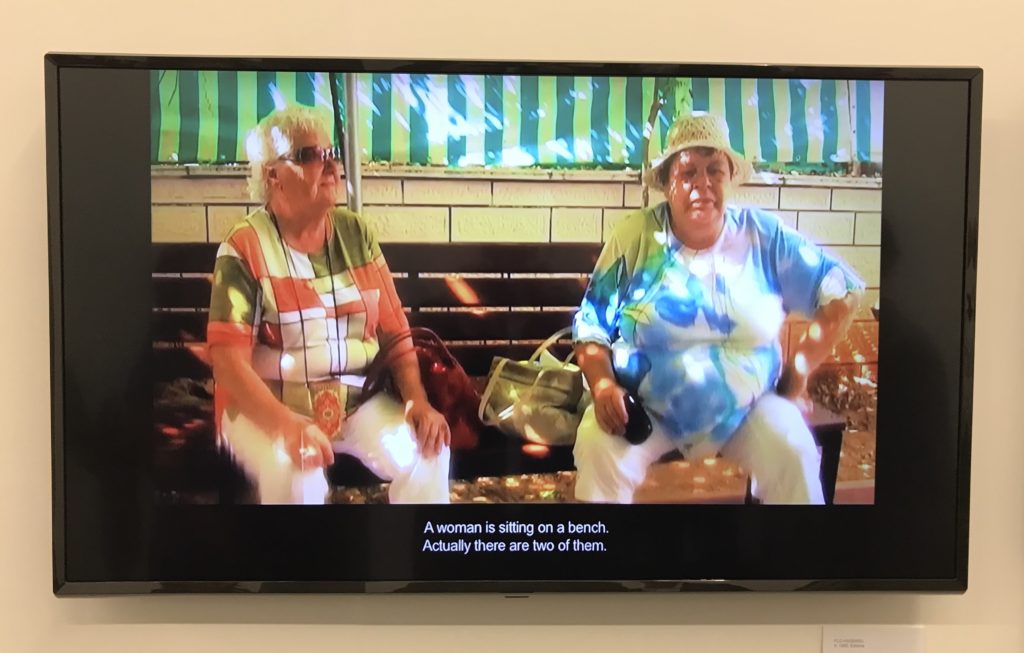
In the late 1990s, the Estonian artist Flo Kasearu accompanied her grandmother and her grandmother’s friend on a vacation to a budget resort in Antalya, Turkey, where the amenities included swimming pools, buffets, and brusque, assembly-line Turkish massages. Kasearu took the opportunity to film the two older ladies, both in their late 60s, as they had a grand old time; more recently, the artist screened the footage for her grandmother, now losing her sight and her memory, and recorded her confused interpretation of the video: “Here they are sitting again somewhere. Two in swimsuits. But why they are sitting here, and where, and who they are, I have no idea.”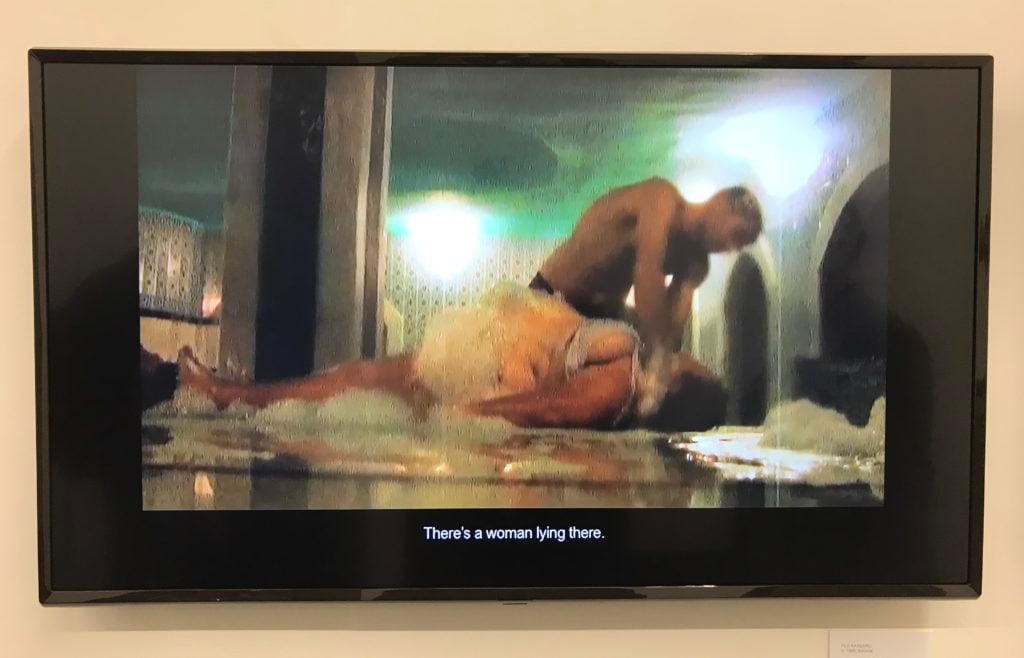
At Temnikova & Kasela’s booth, this video (€5,000) and the subtitled narration unite for a heartbreaking portrait of family and the ironic remove at which the young keep the old, which dissipates spectacularly over time. This lopsided humor is typical in Kasearu’s work, including her best-known project: in Tallinn, she has reclaimed her family house—long seized by Communists and gutted by thieves—and transformed it into a museum, rebuilding her childhood home itself as a kind of sprawling artwork.
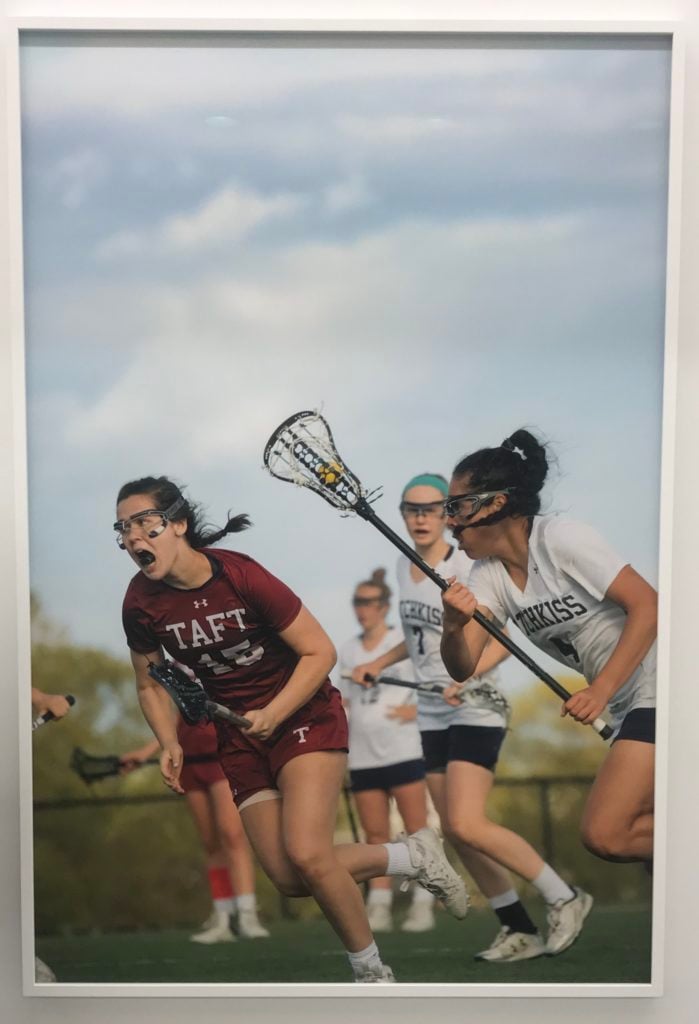
Born in San Francisco, trained at the Städelschule, and now based in Los Angeles, the 31-year-old artist Buck Ellison uses photography to reverse-engineer the jangling semiotics of white, upper-class life in America. To do this, he employs actors and models from the Hollywood and Hollywood-adjacent industry to stage scenes of evidently lived-in cliché, and the result is something like Roe Ethridge meets stock photography—voyeuristic, anthropological, implicitly inviting the viewer to taste the hypocrisy.
At Liste, for instance, one photo shows a scene from a Lacrosse game between Hotchkiss and Taft, leaving one to ruminate on the way an Iroquois war game has become a vehicle for self-actualization among privileged teenage girls at elite East Coast boarding schools. Another suite of images shows a model wearing every hue of a fleece made by Vineyard Vines, the improbably successful Martha’s Vineyard clothing line that has become the preppy uniform of choice.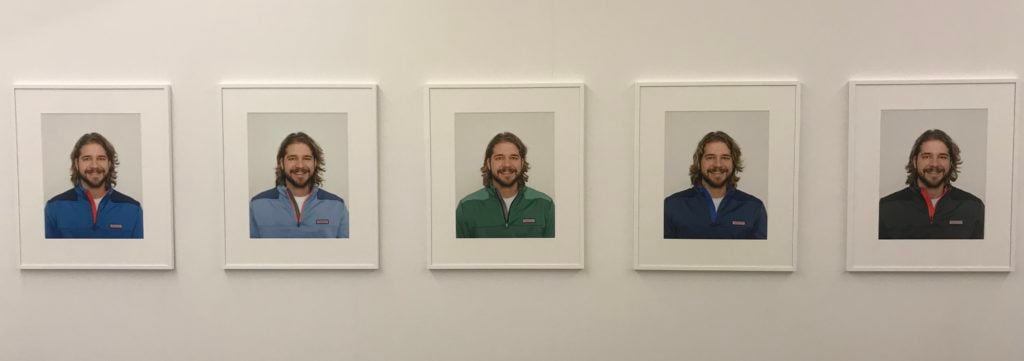
“Their clothes have garnered an enormous following among financiers and have been worn by every living president,” Ellison writes of the photos. “This mental displacement of labor of men in finance or law towards whimsical pursuits (fishing, sailing, drinking) was extremely interesting to me.” One might argue that the functional distance between Ellison’s photos and the photos he is critiquing is vanishingly small, but affluent white American culture presents plenty of opportunities to perfect that balance.
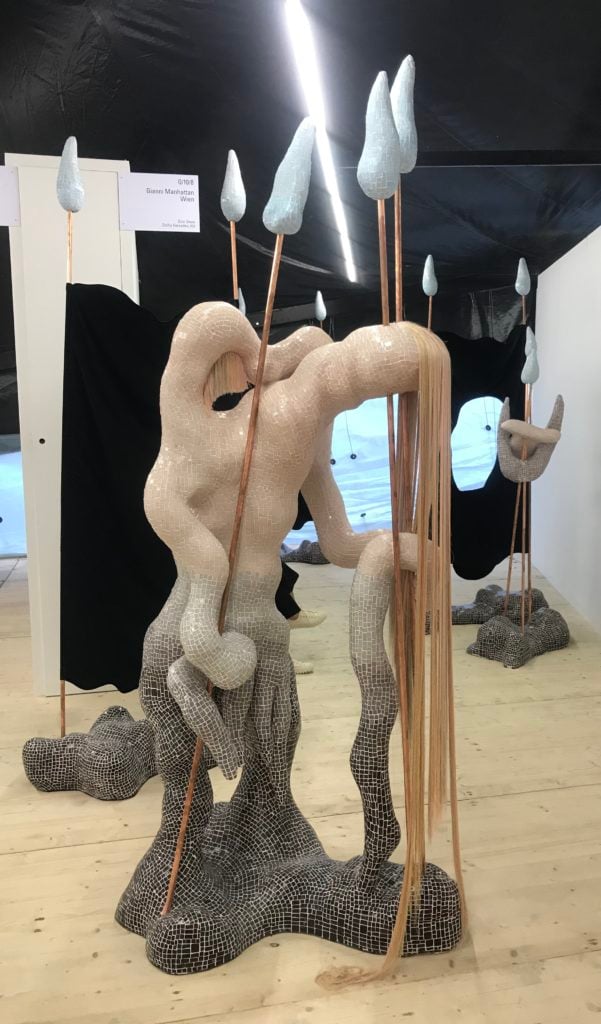
The Budapest-based artist Zsófia Keresztes is disturbed by the concept of digital anthropopgagy, which describes a modern phenomenon whereby the digital and corporal realism of life have begun to eat into each other, morphing symbiotically (or cannibalistically) into some strange new hybrid. In her art, this disturbance gives rise to totemic sculptures that she makes to visualize the binary life form that’s gestating, and—meticulously handmade from cut-glass mosaic, à la Niki de Saint-Phalle—they imagine a gloopy, tribal, self-wounding specter that isn’t all that optimistic. Its head impaled upon two spears, one sculpture at Liste looks positively bummed out, its multicolored nylon hair spilling down with unenjoyed vanity.
Luckily, the artist doesn’t live in such a void of anomie herself. After straining her wrist while working to meet her deadlines for the fair, Keresztes was helped in bringing her display to completion by her family, with her father working on some of the mosaic in his Budapest antiquities shop. In other words, this dystopian vision of a future-shock virtual universe came into being through very human acts of warmth and love, leaving room for some optimism yet.